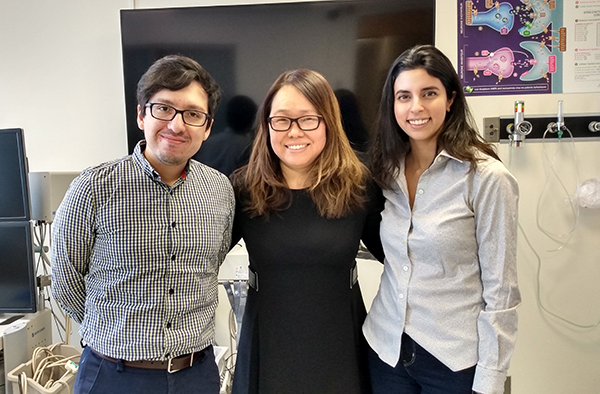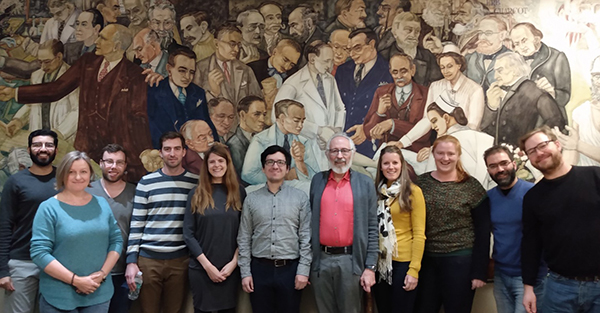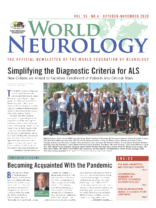My Report of the Canadian Department Visit Program (2019)
by Guillermo Delgado-García, MD
A snowy Montréal received me on a Saturday in mid-November; the previous morning I sat my annual examination and then I was there—3,700 kilometers from Mexico City. After touring Montréal’s museums, Monday arrived and I visited Dr. Anne-Louise Lafontaine, chief of the Department of Neurology of the McGill University Health Centre at the Montreal General Hospital. Dr. Lafontaine was extremely kind, welcomed me warmly, and asked me about my plans for the observership and also for the future.

From left to right: The author, Dr. Eliane Kobayashi, program director of the Frederick Andermann Clinical & Research Fellowship in Epileptology & EEG, and Dr. Dina Namiranian, a senior neurology resident, at the EEG lab.
Back at The Neuro, I looked for Dr. Eliane Kobayashi (Fig. 1) and found her at the weekly epilepsy rounds, held at the EEG lab, where cases are presented and discussed by a world-renowned multidisciplinary epilepsy team, including epileptologists, neurosurgeons, and neuropsychologists, among other highly trained professionals. At the end of the rounds, I introduced myself to Dr. Kobayashi, and she received me with open arms from the beginning. I then joined her team at the Epilepsy Monitoring Unit (EMU). This team was awesome, very friendly, and included Dr. Ghada Abbas (epilepsy/EEG fellow), Dr. Austin Zaloum (neurology resident), and Dr. Rafael Batista João (visiting epileptologist from Unicamp). The EMU is a place specially designed and equipped to care for adult patients undergoing long-term video EEG and is currently considered the gold standard for the diagnosis of epilepsy and seizure-like spells (Epilepsia. 2018;59:27-36).
On Wednesday mornings, I attended McGill’s neurology grand rounds in the de Grandpré Communications Centre, and afterward I stayed there with the neurology residents for the academic half-day activities. One afternoon that first week, I joined Dr. Kobayashi at the outpatient clinic, and there I also met Dr. Giovanni Pellegrino (epilepsy/EEG fellow), with whom Dr. João and I discussed the differences in neurological and epilepsy training in different parts of the world.
On Thursday morning, I met my supervisor, Dr. Birgit Frauscher, at the EEG lab. She was extraordinarily kind, generous, and inclusive all along. From that moment on, I started interpreting routine and prolonged EEGs with her at the reading room. That very day, she introduced me to her wonderful and diverse team from the Analytical Neurophysiology (ANPHY) Lab: Dr. Véronique Latreille, Dr. Petr Klimeš, Dr. Laure Peter-Derex, and Tamir Avigdor. This lab seeks to employ a variety of quantifiable tools in order to shed light on neurophysiological and pathological processes (mainly sleep and epilepsy). In the ANPHY lab, I was also introduced to high density EEG and other advanced source localization techniques.

After one of Dr. Gotman’s lab meetings. In the background, the evocative mural The Advance of Neurology (1955) by Mary (Filer) Spence-Sales can be seen (room 124). From left to right: Abdullah Azeem, Natalja Zazubovits, Tamir Avigdor, Dr. Petr Klimeš, Dr. Birgit Frauscher, the author, Dr. Jean Gotman, Dr. Véronique Latreille, Dr. Willemiek Zweiphenning, Dr. Andreas Koupparis and Dr. Nicolás von Ellenrieder.
That weekend Dr. Frauscher invited me to the First National Training Course on Sleep Medicine, which she organized and chaired. This two-day program was designed to provide a basic working knowledge of sleep medicine for Canadian neurology residents, and included a range of internationally renowned speakers and hands-on practical training on case interpretations of polysomnography. This course allowed me to interact with neurology residents from different universities, as well as with Canadian sleep experts.
The next week, I joined Dr. Frauscher at the outpatient clinic, where she introduced me to the very practical basics of vagal nerve stimulation in epilepsy. Furthermore, she let me get involved in preparing the next stereo EEG planning meeting and this was, in fact, my first real-life exposure to stereo EEG. Meanwhile on the scientific side, on Friday afternoons we all attended Dr. Jean Gotman’s lab meetings, which were both challenging and appealing.
From that week on, I started attending The Neuro’s Killam Lectures, held on Tuesday afternoons, and also the weekly epilepsy conferences, held on Thursday afternoons. The Killam Lectures are supported by the Killam Trusts and are given by outstanding guest speakers whose research is of interest to the scientific community at The Neuro and McGill University. On the other hand, the epilepsy conferences included a case presentation, EEG review, and roundtable discussion.
In my third week, I worked with Dr. Frauscher and Dr. Zaloum at the EMU. It was an intense but also very rewarding week. In addition, I had the opportunity to attend the tribute to Dr. Frederick Andermann (1930-2019), where an international panel of renowned epileptologists gathered to present the latest advances in the field in an homage to Dr. Andermann, director of the epilepsy unit at The Neuro for 35 years and one of the world’s most distinguished epileptologists. This special event was both intellectually stimulating and moving. During the second half of my observership, I also had the honor to work under the supervision of Dr. Martin Veilleux at the EMU.
In addition to the impact of this observership on me in terms of clinical and scientific experience, I really want to highlight another aspect of my visit: the kindness and openness of all the people I met in The Neuro, as so perfectly exemplified by daily lab lunch with Dr. Frauscher and her team. Among those whom I have not mentioned by name above, Natalja Zazubovits and Abdullah Azeem from Dr. Gotman’s lab were eager to help all the time and their assistance was invaluable to me.
One morning there was an exception to my normal work week at The Neuro. On this occasion, I visited the Osler Library of the History of Medicine, a branch of the McGill University Library. This visit was only possible thanks to the immense generosity of Dr. Mary Yearl, the Osler librarian, since the Osler Library was temporarily closed due to a fire at the McIntyre Medical Sciences Building. Rare materials were rehoused in the McLennan Library Building and that was where Dr. Yearl patiently showed me the treasures and rarities of the Osler Library. She later took me to the Osler Room in the McIntyre Building and, even though it was empty, it was evident what Michael Bliss wrote in his book: the Osler Room was “a shrine, architecturally a cross between a church and a mausoleum.” (William Osler: A Life in Medicine, 1999)
Sir William Osler (1849-1919) has been one of my medical and intellectual role models for more than a decade, so this visit had a great impression on me. Although less and less read, many of his insights are still true for general neurology and even for epileptology. The following passage is an example of this: “It is well always to be suspicious of epilepsy developing in the adult, for in a majority of such cases the convulsions are due to a local lesion.” (The Principles and Practice of Medicine, 1892) When we said goodbye, Dr. Yearl told me that I could not leave Montréal without visiting Mont-Royal. Therefore, on my last day before returning to Mexico City, I walked down the Promenade Sir William Osler to the foot of Mont-Royal. It was a misty morning and a few drizzle drops fell from time to time. While there, the main staircase seemed endless to me but, 30 minutes later, I reached the Chalet du Mont-Royal. This trip was physically demanding but also unique, especially for my weakness for misty (and thus cryptic) landscapes.
My experience at The Neuro made me wonder about the unmet needs in my home country regarding the care of persons with epilepsy. I’m sure they are multiple and at different levels. Since my center is a public tertiary referral hospital, I think many of our most complex patients could benefit from long-term video EEG in an elective admission to a specialized inpatient setting (i.e., an EMU). Therefore, a first step might be to start an EMU here and, if successful, to extend this program to other strategic tertiary neurological services nationwide.
I finally want to acknowledge the World Federation of Neurology, The Neuro, and the Canadian Neurological Society for this great initiative that allowed me to experience the Canadian neurological system in an international environment, meet new colleagues, and foster future cooperation. I also want to thank Dr. F. Gonzalez-Crussi (Northwestern University), my long distance mentor, for his insightful comments on an earlier version of this report. •
Guillermo Delgado-García, MD, is a senior neurology resident and MSc student at the National Institute of Neurology in Mexico City.
